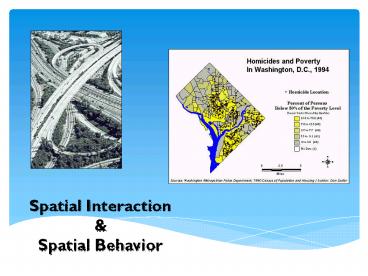Spatial%20Interaction%20 - PowerPoint PPT Presentation
Title:
Spatial%20Interaction%20
Description:
Spatial Interaction & Spatial Behavior-- Why do goods/people move from place to place? -- Personal examples of your spatial interaction ? spatial interaction ... – PowerPoint PPT presentation
Number of Views:94
Avg rating:3.0/5.0
Title: Spatial%20Interaction%20
1
Spatial InteractionSpatial Behavior
2
spatial interaction the movements of peoples,
ideas, commodities within between
placesDeterminants of interaction between two
places communication flows, travel patterns,
migration flows
- -- Why do goods/people move from place to place?
- -- Personal examples of your spatial
interaction?
3
Models of Spatial Interaction
- How do we create models to describe the pattern
of flows between different places? - Through either micro or macro theories
- Ullmans flow determining model
- I. Complementarity
- II. Transferability
- III. Intervening Opportunity
4
- Complementarity supply of something in one
place demand for it in another
5
- Transferability exchange of product occurs
between both sides and depends on - The characteristics/value of a product
- The distance (in time and money penalties) over
which it needs to be moved. - The ability of the commodity to bear the costs of
movement. - transferability decreases with distance
6
- Intervening Opportunity a closer option will
change interaction - intervening opportunity increases with distance
Sunrise
Miami
7
- You have a product in California that you need
but the cost of transportation is too much. This
is an example of - A. complementarity and transferability
- B. complementarity but no transferability
- C. an intervening opportunity
- D. transferability but no complementarity
- E. A, B, C, D
8
Measuring Spatial Interaction
- i. Distance Decay (the friction of distance)
- ii. The Gravity Model (size distance affect
interaction) - iii. The Potential Model
- iv. Movement Biases (distance, direction,
network bias)
9
- Distance decay the decline of activity with
increasing distance from the point of origin - inverse-square relationship (j-curve)
10
- Density of BMI-healthy food outlets in New York
City - Closer to a BMI health food store, what happens
to obesity levels?
11
- What variations in distance decay curves might
you expect if you were to plot shipments of the
following - 1. concrete
- 2. potato chips
- 3. Nike shoes
- What do these respective curves tell us about
transferability?
12
ii. The Gravity Model
- A model that expresses interaction
- between two places as a function of
- -the size of the two places (population)
- -the distance between them
- The physics of size versus distance
- Sir Isaac Newton said Any two objects
attract each other with a force that is
proportional to the product of their masses and
inversely proportional to the square of the
distance between them - Big things attract more than smaller things,
and things closer to each other have a stronger
mutual attraction.
13
The Gravity Model In Action
- Larger shopping centers attract more than smaller
ones. - Larger cities better lives/fortune/culture
- Other important factors
- Size
- Social status
- Diversity of commodities offered
- Travel time
- Cost
- Effort
14
Predicting Travel Routes
15
Predicting Computer Purchases
16
Law of retail gravitation a predictive model to
select the most profitable business locations
Breaking point location beyond it, another
town dominates that market area.
How does this affect, say Sawgrass Mills? Or
nightlife on South Beach?
17
The Potential Model
- Measures interactions between one location
every other location - Measures the potential amount/weight of
interactions (good for studying retail behavior,
marketing, broadcasting) - E.g. You have more than two stores to choose
from.
18
Predict Interactions between sites A-D with 1-9
19
iv. Movement Bias
- What creates the movement bias problem?
- Natural and cultural barriers preventing ideal
gravity/flow model - Why are we forced into certain kinds of spatial
behaviors? - - DISTANCE BIAS Often prioritizes short
movements vs. long - - DIRECTIONAL BIAS From a given origin, flows
are not random. (North/South or East/West) - - NETWORK BIAS When nodes are connected via
links, those links are more likely to be used.































